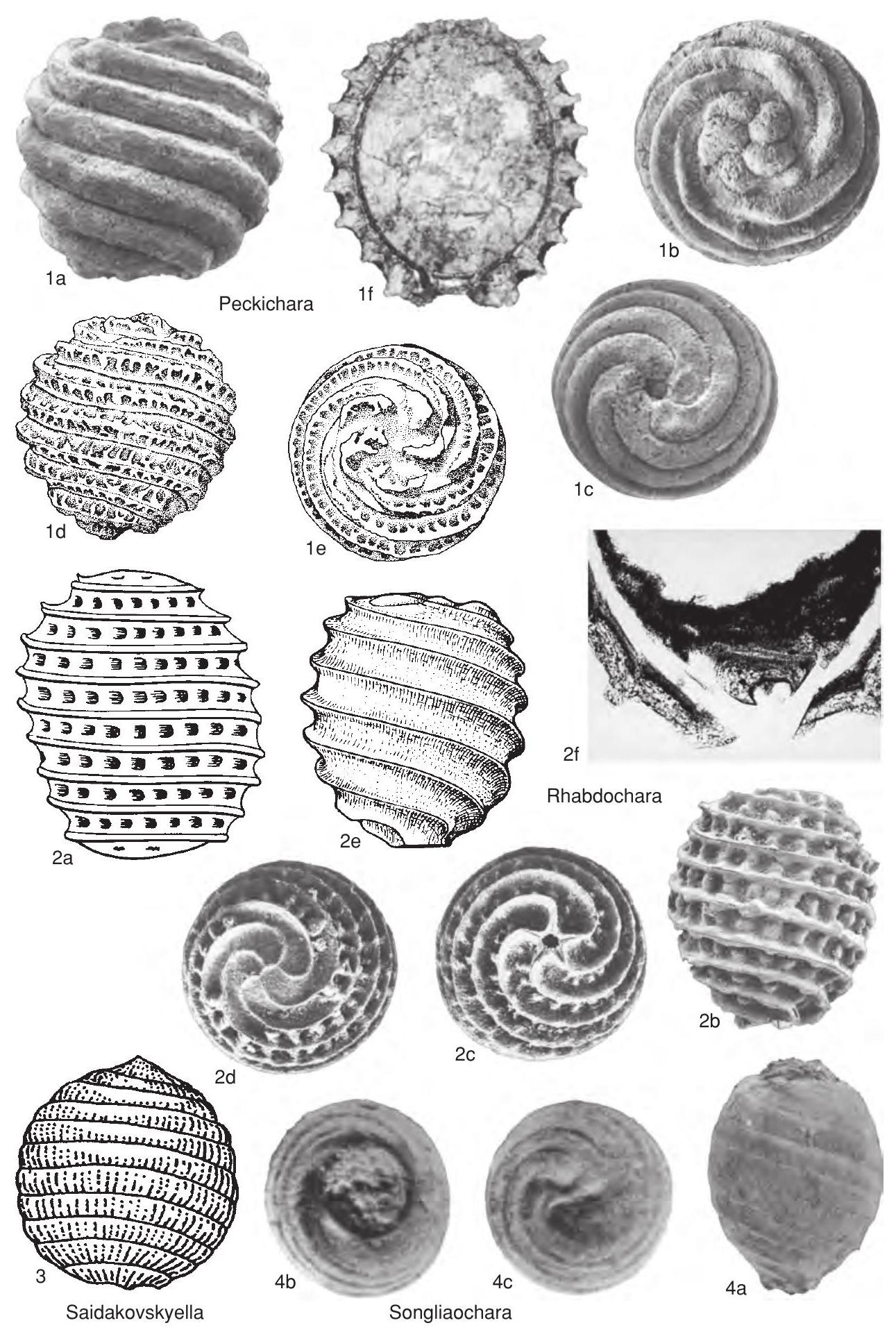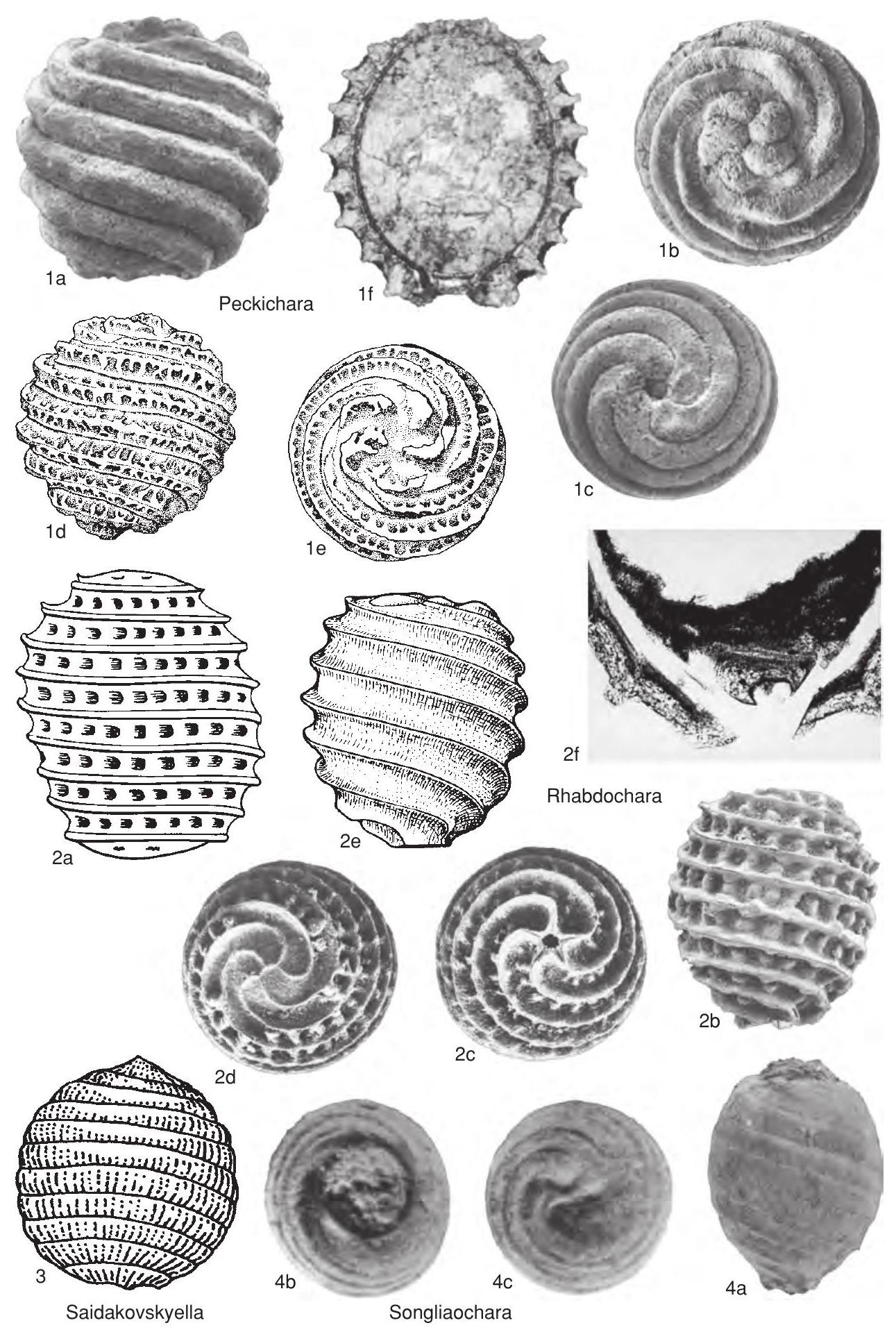Welcome to the Treatise on Invertebrate Paleontology!
Please enter a genera name to retrieve more information.

Peckichara
Classification
Phylum:
Charophyta
Class:
Charophyceae
Order:
Charales
Suborder:
Charineae
Family:
Characeae
Subfamily:
Charoideae
Formal Genus Name and Reference:
Peckichara GRAMBAST, 1957, p. 352
Type Species:
P. varians GRAMBAST, 1957, p. 352, pl. VIII, 1-8, OD
Images
(Click to enlarge in a new window)
Fig. 73, 1a-c. *P. varians Grambast, lower Eocene, France, topotypes, a, lateral view, C.57-9, b, apical view, C.57-10, c, basal view, C.5711, × 40 (new).”, “——Fig. 73,1d-e. P. pectinata Grambast, Upper Cretaceous, France, d, lateral view, e, apical view, × 46 (Grambast, 1971, text-fig. 9a-b).”, “——Fig. 73, 1f. P. toscarensis Feist, Paleocene, Spain, longitudinal section, C.1124-8, × 40 (new).”
Synonyms
Sinochara
Geographic Distribution
USA, Peru, France, United Kingdom, Spain, Algeria, China, ?India, Mongolia
Age Range
Beginning Stage in Treatise Usage:
Upper Cretaceous-Paleogene (Eocene, ?Oligocene)
Beginning International Stage:
Cenomanian
Fraction Up In Beginning Stage:
0
Beginning Date:
100.5
Ending Stage in Treatise Usage:
Paleogene (Eocene, ?Oligocene)
Ending International Stage:
Chattian
Fraction Up In Ending Stage:
100
Ending Date:
23.04
Description
Apex nitellopsidoid, with periapical furrow weakly marked and variable narrowing of spirals, Apical nodules present, generally elongated, General shape prolate spheroidal and often quadrangular, with rounded apex, base rounded or slightly tapering, with flaring funnel, Spirals generally with tubercles, rods, or crests, Basal plate as thick as about one-third width, Size small to large. [[Retusochara and Peckisphaera have similar apical structures and thick basal plates; plate is sunken in Retusochara but in some species is still visible from the exterior.]
References
Museum or Author Information
Classification
Phylum:
Charophyta
Class:
Charophyceae
Order:
Charales
Suborder:
Charineae
Family:
Characeae
Subfamily:
Charoideae
Formal Genus Name and Reference:
Peckichara GRAMBAST, 1957, p. 352
Type Species:
P. varians GRAMBAST, 1957, p. 352, pl. VIII, 1-8, OD
Images
(Click to enlarge in a new window)
Fig. 73, 1a-c. *P. varians Grambast, lower Eocene, France, topotypes, a, lateral view, C.57-9, b, apical view, C.57-10, c, basal view, C.5711, × 40 (new).”, “——Fig. 73,1d-e. P. pectinata Grambast, Upper Cretaceous, France, d, lateral view, e, apical view, × 46 (Grambast, 1971, text-fig. 9a-b).”, “——Fig. 73, 1f. P. toscarensis Feist, Paleocene, Spain, longitudinal section, C.1124-8, × 40 (new).”
Synonyms
Sinochara
Geographic Distribution
USA, Peru, France, United Kingdom, Spain, Algeria, China, ?India, Mongolia
Age Range
Beginning Stage in Treatise Usage:
Upper Cretaceous-Paleogene (Eocene, ?Oligocene)
Beginning International Stage:
Cenomanian
Fraction Up In Beginning Stage:
0
Beginning Date:
100.5
Ending Stage in Treatise Usage:
Paleogene (Eocene, ?Oligocene)
Ending International Stage:
Chattian
Fraction Up In Ending Stage:
100
Ending Date:
23.04
Description
Apex nitellopsidoid, with periapical furrow weakly marked and variable narrowing of spirals, Apical nodules present, generally elongated, General shape prolate spheroidal and often quadrangular, with rounded apex, base rounded or slightly tapering, with flaring funnel, Spirals generally with tubercles, rods, or crests, Basal plate as thick as about one-third width, Size small to large. [[Retusochara and Peckisphaera have similar apical structures and thick basal plates; plate is sunken in Retusochara but in some species is still visible from the exterior.]

